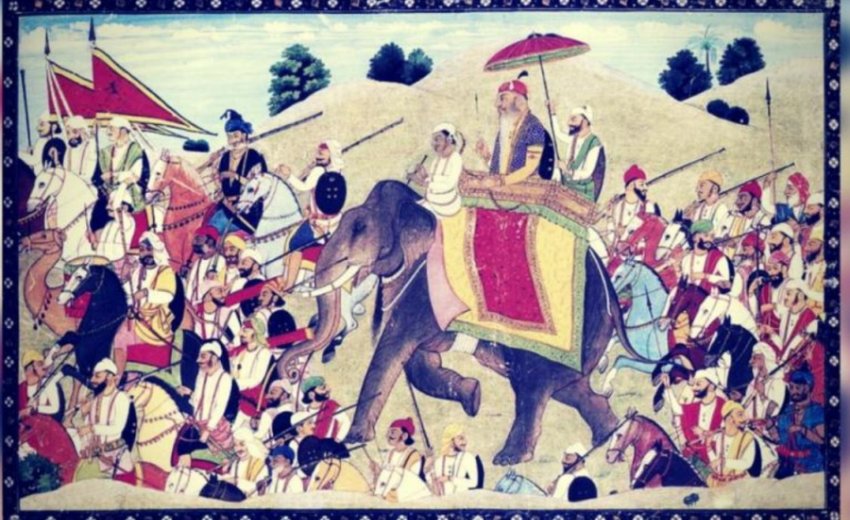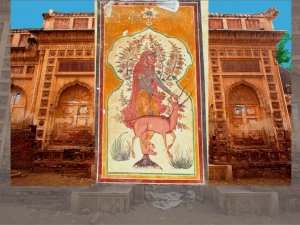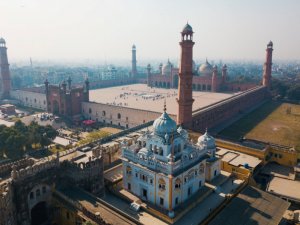The most enduring landmark of Sardar Hari Singh Nalwa's legacy in Pakistan is the country's western border with Afghanistan, which also once represented the furthest limits of the Sikh empire. However, it was in the Hazara region in today's Khyber Pakhtunkhwa province that Nalwa spent the bulk of his time on the frontier. Although local history sources contain a wealth of information on Hari Singh Nalwa's fifteen-year tenure as Governor of Hazara, they have not received adequate scholarly attention. Foremost among these is the remarkable Tawarikh-e-Hazara. This book was penned in Persian in 1846 by Lala Mehtab Singh, who hailed from Musanagar (Kanpur) and joined Nalwa's service in Hazara in 1824. As my ancestor Painda Khan Tanoli, of Amb-Darband in Hazara, was a contemporary and prominent rival of Nalwa, our elders also passed down rich oral and written traditions that shed light on the towering figure of nineteenth century South Asian history whose legacy on the frontier is often misunderstood. It is my earnest desire to see these local narratives from Hazara added to existing knowledge of Nalwa in an objective manner, before they fade away from memory and relevance.
The Political Economy of Conflict in Hazara
Hazara occupied a strategically important position at the beginning of the early nineteenth century, as the Durrani Afghans crossed the Indus and used routes through Hazara to access the wealth of Kashmir. Therefore, control of Hazara became increasingly important to Maharaja Ranjit Singh's Lahore Durbar as it attempted to take control of Kashmir away from the Durranis. This was bad news to the native tribes of the region who were used to maintaining their political autonomy. Both the Sikhs and Durranis experienced turbulence with the locals. In 1817, my ancestor Nawab Khan Tanoli was killed by Azim Khan Durrani, the Afghan Governor of Kashmir, for challenging Durrani authority in the region (1). Around the same time, Southern Hazara under the leadership of Muhammad Khan Tareen rebelled against growing Sikh control. Muhammad Khan Tareen was a distant ancestor of Pakistan's first military dictator, General Ayub Khan, and a powerful chief who had formerly collected taxes from the region and paid them to the Sikh Empire's agents at Attock Fort. The cause for the rebellion was an increase in annual tax demands from 5,000 to 25,000 Rupees (2).
To alleviate the resistance against the Lahore Durbar, Ranjit Singh's crafty mother in law Mai Sada Kaur visited Hazara in 1818 with Sher Singh and a military contingent of 300 men from Lahore headed by Illahi Baksh (3). They built a fort at Tarbela in Hazara; Mai Sada Kaur adopted Muhammad Khan Tareen as her son and Maharaja Ranjit Singh later convinced him to accept a jagir of Rs. 20,000 to maintain peace in the region (4). Despite the efforts towards reconciliation with Hazarawal political elites, several notable Sikh officers like Makhan Singh, Diwan Ram Diyal and Amar Singh Majithia fell at the hands of local tribal chiefs who resented their decreasing autonomy (5).
The historian Hari Ram Gupta crudely assessed that conflict in Hazara was driven by "the religious zeal and bigotry" of the natives (who he incorrectly identifies as Yusufzai Pashtuns) (6). However, the above chain of events identifies excessive taxation and loss of political autonomy to both Durranis and Sikhs as the realistic drivers of conflict.
Nalwa's Military Campaign in Hazara
Maharaja Ranjit Singh appointed Nalwa the Jagirdar-Governor of Hazara in 1822 following the latter's decisive victory in an unplanned battle where the odds were heavily stacked against Nalwa. In 1821, Nalwa was rushing from Kashmir to Mankera when his forces were intercepted in Hazara. A large body of Jadun tribesmen had blocked the narrow pathway at Mangal, on the outskirts of modern-day Abbottabad, and demanded Pashmina shawls in return for right for passage. Hari Singh Nalwa sent Najeebullah Khan Swati and Lala Raj Kunwar to negotiate with the tribesmen on his behalf three times (7). After three failed attempts through the local intermediaries, Nalwa took the fort at Mangal by storm. Local records mention that the Sikh forces that scaled the walls of the Mangal Fort at dawn were headed by an Iqbal Singh who displayed exemplary courage. The defeated tribesmen sent delegations of local Hindus and Sikhs from Nawanshehr and Dhamtor in Hazara to parley with Nalwa on their behalf. Nalwa permitted the Jaduns to resettle in their captured territory on the condition that each house in Nawanshehr, Dhamtor and Rajoyya pay five and a half rupees as fines for the inconvenience caused (8).
On becoming the Governor of Hazara in 1822, Nalwa built the Harkishangarh Fort a mile east of the city of Haripur, at a strategic location pointed out him by his local Muslim ally Muqaddam Musharraf who was from the Gujjar tribe (9). This would remain the Lahore Durbar's largest fort in Hazara. However, it would take Nalwa two years to further cement his authority in the region. A series of toughly contested battles took place at Srikot, a mountain retreat of the Mashwani tribe that had become a seat of resistance for chiefs from around Hazara who fell out of favour with the Durbar. In 1824, Maharaja Ranjit Singh himself participated in the Hazara campaign when Nalwa was seriously wounded while attempting to take Srikot from a confederation of local tribes (10).
Control of Hazara was firmly established in 1824 when, on Nalwa's local ally Muqaddam Musharraf's advice, the following chiefs were apprehended and blown away from cannons following a battle at Srikot: Bostan Khan Tareen of Dervesh, Sher Muhammad Khan of Saraye Saleh, Saleh Muhammad Mashwani, Saleem Shah Mashwani, Jalal Khan Dilazak of Saraye Saleh and Sheikh Jadun of Rajoya. Srikot was garrisoned by the Sikh empire and the Mashwani tribe was driven out of their mountain range for two years (11). The Mashwanis were only allowed to return when elders of the tribe promised Nalwa that they would not cause further trouble to the Lahore Durbar (12).
After 1824, my ancestor Painda Khan Tanoli of Amb-Darband was the only chief left to continue the resistance in Hazara - a point to note is that he was at war not just with Nalwa but also simultaneously with the Afghan Durranis and Syed Ahmed Barelvi. This explains why Edward Conolly referred to Painda Khan as a "a sort of wild man, at war with all around him," (13) who would cross the river Indus with his tribal army on inflated goat skins to ambush garrisons built by the regional powers in his native lands. Nalwa was aware that Painda Khan's father, who was put to death by the Afghan Governor of Kashmir, had as his dying wish made his son swear an oath never to trust an outside ruler. Perhaps sympathetic to his solitary condition, Nalwa made unsuccessful peace overtures to my ancestor no less than five times until his death in Jamrud in 1837 (14).
Nalwa was therefore surprised when he received a letter from the reclusive Painda Khan requesting his assistance against Syed Ahmed Barelvi, an angry preacher from UP who wanted to rally the frontier tribes in Jihad (Holy war) against the Sikh Empire. Barelvi and his men had captured my family's seat of power at Amb-Darband after my elders' refusal to become part of their war. Additionally, the strict version of Islam Barelvi preached was at odds with the flexible folk Islam traditionally practiced by local communities.
Hari Singh Nalwa agreed to provide military support against Barelvi in return for Painda Khan sending his eldest son, Jahandad Khan, to Nalwa as a guarantee of good will. Jahandad was a boy of eight years at the time. Interestingly, the exchange between the two rivals making common cause against Barelvi was preserved as poetry by local bards. Syed Murad Ali Aligharhi translated the folk poetry into Urdu in the 1870s (15). An excerpt from his translation is as follows:
Barelvi's forces were driven out of Amb-Darband with the help of the Sikh reinforcements. The alliance was short lived as the old differences between Nalwa's lieutenant Mahan Singh and Painda Khan Tanoli soon resurfaced, and they were back to skirmishing (16). This also meant that the eight-year-old Jahandad Khan spent a few years in Nalwa's custody before he was able to rejoin his family.
It's important to clarify that despite his robust military presence, Nalwa's control was never established in all of Hazara. Local sources and the Umdat Ut Tawarikh ascertain that Painda Khan Tanoli, based in the Trans-Indus Tanawal belt, continued to be a source of disturbance to Nalwa throughout the 1830s - launching prominent attacks on the Lahore Durbar's forces in Mansehra, Kiriplian, Qadirabad, Shergarh, Parhena, Bhirkund, Nilore, Agror and Bharukot. As late as 1836, the Umdat ut Tawarikh mentions that Maharaja Ranjit Singh was annoyed with Nalwa "for in spite of that fact that there were 8,000 horse and foot with the Sardar, the affair of Painda Khan had not yet been over" (17). Our elders told us that control of the Shergarh Fort, which was built by Diwan Bhawani Das in 1819 and is currently in custody of my family, changed hands seventeen times between Painda Khan and the Sikh Empire between 1824 and 1844.
Administration
Nalwa managed Hazara through 4000 men from his personal Jagirdari forces, who were stationed in 80 forts and towers in Hazara at an annual cost of 200,000 rupees (18) (19). Reinforcements were summoned from Lahore when the need arose. As Jagirdar-Governor, Nalwa's primary responsibility was to collect taxes from the region and deposit a fixed amount into the state treasury, while ensuring that the pathways to Kashmir remained clear of the Durrani Afghans (20). In the early years, he did this by directly appointing the following officers as Thanedars in Hazara: Gulab Singh at Shinkiari, Dal Singh at Galli Badral, Hukam Singh at Mansehra, Diwan Bhawani Das for Tanawal, Syed Hassan Shah at Nilan, Fateh Singh at Tarbela and Mool Singh at Saraye Saleh (21).
Nalwa took several steps to develop Hazara's economy. These were done not only to offset the high military expenses, but also to fund a number of key social, administrative and political projects in the region. These would come as a surprise to those accustomed to viewing Nalwa primarily as the fighting arm of the Sikh Empire. The table below provides a summary of the types and numbers of the grants given out by Jagirdar-Governor Nalwa in Hazara (22).
To improve the revenue generating potential of the region, Nalwa developed critical irrigation infrastructure in the Haripur plains. Known as the Rangila Canal, the water distribution system introduced by Nalwa on the Dor River for the first time allowed modern agriculture as well as urban settlements to spring up in the Haripur plains (23). The Sikhs collected revenue on agricultural produce twice a year. Although official policy was to demand half of output, a third was usually collected (24). Additional sources of revenue in the region were taxes on grazing livestock and Jandars (water mills).
The water distribution system, gardens and groves laid down by Nalwa in Haripur and Khanpur laid down the foundations for citrus farming in the region, which is a key driver of the local economy even today (25). Security was provided to traders traveling between Hazara's three commercial hubs (Haripur, Baffa and Nawanshehr), and Khatri traders migrated from northern Punjab moved to Hazara to set up shop in Hazara.
Nalwa's legacy as a diplomat who tackled insurgency through political settlements is largely forgotten today. Of the 125 Jagirs that existed in Hazara under British rule in 1883, 102 were continuations of Jagirs granted under Sikh rule, primarily by Nalwa (26).
Muhammad Khan Tareen, Mir Zaman Khan Utmanzai, Habibullah Khan Swati, Hassan Khan Karlal, Sher Muhammad Tanoli, Muhammad Khan of Jalloh and Faiz Ali Shah of Kaghan were some of the leading chiefs from Hazara who were rewarded with Jagirs by Governor Hari Singh Nalwa in return for abandoning resistance (27). Alexander Burnes detailed reports also mention the settlements made with and tribute taken by Nalwa from the major Pashtun tribes west of the Indus (39).
As the urban regions were settled after 1824, Nalwa turned over day to day administration of Hazara to Mahan Singh Mirpuri (28). His loyal lieutenant had stood by Nalwa's side at a time when others deserted him, when he was severely injured at the battle of Srikot in 1824. On assuming administration, however, Mahan Singh replaced Nalwa's handpicked officers in Hazara with his own relatives (29). Two of Mahan Singh's brothers were appointed Thanedars at Saraye Saleh and Mansehra, and a cousin was assigned the task of collecting revenues from Tanawal.
Mahan Singh was far less effective at managing relations with the local tribes than Nalwa, and frequently created headaches for the Lahore Durbar in the region. His decision to kidnap and humiliate Sher Muhammad Tanoli, a Jagirdar appointed by Nalwa, led to rebellion in the Tanoli country that would continue till the next two decades (30).
None of the Governors appointed by the Lahore Durbar after Nalwa's death in Jamrud in 1837 could match his administrative and military abilities. Ten years after Nalwa's death, the British sent in a survey team comprising Peter Van Agnew and Henry Lumsden to Hazara to negotiate ways to transfer the region to Dogra control without bloodshed. On 6th February 1847, the team reported that "the people are all willing to tender allegiance to Maharaja Golab Singh on his guaranteeing to them what they held in the time of Sirdar Hurree Singh" (31).
Was it a clash of religions?
As mentioned earlier, the root causes of the conflict lay in the challenging of the status quo by the expanding Sikh empire. Prior to Sikh rule, Haji Wahab, an agent of the Durrani rulers had also perished while attempting to collect taxes from Hazara in 1803 (32).
A large number of Punjabi Muslims served in the Sikh army stationed in Hazara; similarly, there is evidence that the resistance in Hazara became a destination for Hindus and Sikhs escaping the Lahore Durbar's reach. As early as May 1820, Nand Singh, the Thanedar of Rawalpindi who fell out of favour with the Maharaja escaped to Hazara and made common cause with the "mischief makers of Darband" (33). When my ancestor Painda Khan attacked the Sikh fort in Mansehra in 1832, he had to confront a local Muslim army headed by Saddam Khan Jahangiri, who was appointed Mayor of Mansehra city by Hari Singh Nalwa (34). When the Muslim Mayor was slain by the tribal army, his young son Muhammad Zaman Khan was handsomely rewarded by Nalwa with 1000 kanals of land, and revenue rights to three villages and three water mills (40). It seems unlikely that any of the above could have happened if the conflict between Nalwa and local tribes in Hazara had strong religious undertones.
However, the ban on beef eating and Azan (call to prayer) imposed by Ranjit Singh on the 95 per cent Muslim majority population of Hazara was an extremely weak public policy move. Even if it was only implemented in the urban areas under direct Sikh control, it was widely seen as an action hostile to Islamic beliefs.
Which was the moral army?
There is ample evidence that the Afghan, Sikh and Hazarawal political elites locked in realpolitik were pragmatic in their dealings with one another, and even became allies when it suited their interests. However, any decent and enlightened citizens of the twenty first century would be appalled by some of the acts committed by all sides:
- Plundering and bullying non-combatants to induce fear in the general population was considered fair game by all parties. My own ancestor had the unsavory habit of throwing rich merchants into the Indus after chaining heavy rocks around their necks - sometimes even after collecting ransom payments from them. Syed Ahmed Barelvi, who had come from UP to unite the Muslim tribesmen in a holy war against Ranjit Singh, plundered and destroyed a rich trading hub bordering Hazara at Hazro in 1823 (35). In 1824, William Moorcroft found Peshawar's houses, gardens and orchards in ruins after the Sikhs took control of the city for the first time (36).
- Nalwa locked up in a well and starved to death Muhamad Khan Tareen, one of the most respected chiefs of Hazara, after he developed differences with the Sikh Empire. Following his death, each family under Sikh control in Hazara was forced to pay 2.5 Rupees to cover the 50,000 Rupees expense Nalwa incurred when he 'purchased' the release of Muhammad Khan Tareen from Maharaja Ranjit Singh's captivity (37).
- In 1821, the Swati tribe destroyed the Sikh garrison at Shinkiari and carried away around 300 Sikh and Hindu women residing therein. As retaliation, Nalwa conducted a lightening raid on peasants in the Konsh, Agror and Nindhar glens in northern Hazara and captured around 1000 Muslim women and children. All of the Sikh, Hindu and Muslim women were returned after negotiations between Nalwa and the Khan of Garhi Habibullah (38).
Had our historians encouraged a culture of introspection and critical thinking instead of chest thumping to half-truths, perhaps an exact repeat of the senseless murder, carnage and violence on women at the time of partition could have been avoided.
In February 2019, I experienced an emotional journey with a group of twenty Sikh guests visiting Pakistan from the United States and Singapore. We went to the sites in Hazara that witnessed the complex relationship between Nalwa and my elders in an unforgiving world six generations ago. We celebrated with a large group of locals the 200th anniversary of Shergarh, one of the few Sikh era forts in Pakistan that survives in its original form. A month earlier, a group of my friends in Haripur had taken a stand to prevent the demolition of the Harkishangarh Fort built by Nalwa, citing its importance to our once shared past. History remembers the mountains of the frontier for many things - but rarely for compassion. As the urban centers of South Asia increasingly appear captive to the petty posturings of identity politics, perhaps hope for the future thrives in the unlikeliest of places.
References:
1. Mehtab Singh, Tawarikh-e-Hazara (Translated by Dr. Sher Bahadur Panni). 1846. pg. 95.
2. Sohan Lal Suri, Umdat-ut-Tarawikh, Daftar II, Guru Nanak Dev University Amristar. 2002. pg. 240.
3. Mehtab Singh, Tawarikh-e-Hazara (Translated by Dr. Sher Bahadur Panni). 1846. pg. 104.
4. ibid pg. 109.
5. Hari Ram Gupta, History of the Sikhs, Volume V, Munshiram Manoharlal Publishers Pvt. Ltd. 2008. pg. 149-150.
6. ibid. pg. 144.
7. Mehtab Singh, Tawarikh-e-Hazara (Translated by Dr. Sher Bahadur Panni). 1846. pg. 106.
8. ibid. pg. 108.
9. ibid. pg. 110.
10. Vanit Nalwa, Hari Singh Nalwa Champion of the KhalsaJi. Manohar Publishers and Distributors. 2009. pg. 89.
11. Mehtab Singh, Tawarikh-e-Hazara (Translated by Dr. Sher Bahadur Panni). 1846. pg. 125-126.
12. ibid. pg. 126.
13. Capt Edward Conolly, Journal of the Asiatic Society of Bengal, Volume IX, Bishop's College Press. pg. 931.
14. Syed Murad Ali Aligarhi, Tarikh-e-Tanolian, Maktaba-e-Qadriyya, Jameh-Nizamiya-Rizviya. 1875.
15. ibid. pg. 53.
16. ibid. pg. 57.
17. Sohan Lal Suri, Umdat-ut-Tarawikh, Daftar III (Parts i-iii), Guru Nanak Dev University Amristar. 2002. pg. 379.
18. Vanit Nalwa, Hari Singh Nalwa Champion of the KhalsaJi. Manohar Publishers and Distributors. 2009. pg. 102.
19. Journals and Diaries of the Assistants to the Agent, Governor-General, Northwest Frontier and Resident at Lahore (1846-1849), Sang-e-Meel Publications. pg. 74.
20. Vanit Nalwa, Hari Singh Nalwa Champion of the KhalsaJi. Manohar Publishers and Distributors. 2009. pg. 102.
21. Mehtab Singh, Tawarikh-e-Hazara (Translated by Dr. Sher Bahadur Panni). 1846. pg. 127.
22. Gazetteer of the Hazara District 1883-4, Sang-e-Meel Publications.2013. pg. 200-202.
23. Vanit Nalwa, Hari Singh Nalwa Champion of the KhalsaJi. Manohar Publishers and Distributors. 2009. pg. 93.
24. Gazetteer of the Hazara District 1883-4, Sang-e-Meel Publications.2013. pg. 181.
25. ibid. pg. 202.
26. ibid. pg. 202.
27. Dr. Sher Bahadur Panni, Tarikh-e-Hazara, Maktaba Jamal. 2016. pg. 423.
28. Mehtab Singh, Tawarikh-e-Hazara (Translated by Dr. Sher Bahadur Panni). 1846. pg. 122.
29. ibid. pg. 127.
30. Ibid. pg. 128
31. Journals and Diaries of the Assistants to the Agent, Governor-General, Northwest Frontier and Resident at Lahore (1846-1849), Sang-e-Meel Publications. pg. 312.
32. Mehtab Singh, Tawarikh-e-Hazara (Translated by Dr. Sher Bahadur Panni). 1846. pg. 99.
33. Sohan Lal Suri, Umdat-ut-Tarawikh, Daftar II, Guru Nanak Dev University Amristar. 2002. pg. 345.
34. Ghulam Nabi Khan, Al Aghan Tanoli, Al Tariq Printers Rawalpindi. 2001. pg. 193.
35. Altaf Qadir, Sayyid Ahmad Barailvi - His Movement and Legacy from a Pakhtun Perspective, SAGE. 2015. pg. 65.
36. William Moorcroft, Travels in the Himalayan Provinces of Hindustan and the Punjab, Volume II, Asiatic Society of Calcutta. pg. 337.
37. Mehtab Singh, Tawarikh-e-Hazara (Translated by Dr. Sher Bahadur Panni). 1846. pg. 126.
38. ibid. pg. 113.
39. Alexander Burnes, Reports and Papers, Political, Geographical and Commerical, Bengal Military Orphan Press. pg. 1.
40. Ghulam Nabi Khan, Al Aghan Tanoli, Al Tariq Printers Rawalpindi. 2001. pg. 195.
Jahandad Khan
[email protected]




